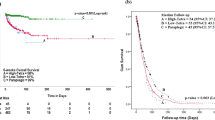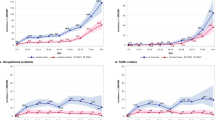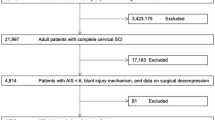Abstract
Among 2011 patients treated on the Spinal Cord Injury Service the mortality was 304 (15 per cent.).
The mortality among 1851 patients with traumatic paraplegia was 258 (13.9 per cent.), which has been analysed in detail.
Of 258 deaths, 172 (67 per cent.) were related and 58 (22 per cent.) were unrelated to the injury; 28 deaths (11 per cent.) remained undetermined as to relationship with spinal cord injury.
The corrected mortality among 1851 patients with traumatic paraplegia was 200 (10.8 per cent.).
The mortality of 160 patients with non-traumatic paraplegia was 46 (29 per cent.).
The uncorrected mortality among 1851 patients with traumatic paraplegia was highest, 16.5 per cent., in the group with lower thoracic lesions (T7 to 12); next the upper thoracic group (T1 to 6), 13.5 per cent.; next the cervical lesions, 12.4 per cent.; and lastly, the lumbo-sacral lesions, 11.4 per cent.
The uncorrected mortality among patients (564) with cervical lesions was 12.4 per cent., that of all remaining patients (1287) was 14.5 per cent.
Age at injury played a greater role than level and extent of injury regarding the average survival time not only among the deceased, but also among the still living patients.
Of the original group of 180 patients on 1 April 1946, 132 patients are still alive, ie., 73 per cent. have survived 20 years or more. Of 1593 living patients with traumatic paraplegia, 379 (23.8 per cent.) have survived 20 years or more, and 1002 (62.9 per cent.) have survived 10 to 19 years.
The annual death rate from 1962 to 1965 was 1.6 per cent. among our patients as compared to 0.95 per cent. for the U.S.A. and 0.83 per cent, for California.
Renal failure was the most frequent cause of death, namely, 85 of 258 deaths (32.9 per cent.); renal failure plus amyloidosis occurred in 13 (15.2 per cent.), and renal failure with hypertension in 7 (8.2 per cent.) cases. Of the 1851 traumatic paraplegic patients, 5 per cent. have died from renal failure. Renal failure was more frequent with thoracic than other levels.
If a patient survives 15 years without serious renal complications, the probability of renal death declines.
Secondary amyloidosis was the cause of 24 of 99 necropsies (24.2 per cent.) or of 258 deaths (9.6 per cent.) or approximately 2 per cent. of 1851 patients with traumatic paraplegia. Amyloidosis was more frequent with thoracic than other levels. The survival time of patients with amyloidosis resembled that of patients with renal failure.
Pulmonary complications caused 18 of 258 deaths (6.9 per cent.) or 0.9 per cent. of 1851 patients with traumatic paraplegia. Of the 18 deaths, 13 (72.2 per cent.) occurred in patients with cervical cord lesions.
Overt suicide was the cause of 21 of 258 deaths (8.1 per cent.) or 1.3 per cent. of all patients with traumatic paraplegia. Suicide could not be related to either the age of the patient or the level of injury. Drugs and gunshot wounds were the foremost among causes of suicide.
Vascular conditions, including cardiac, cerebrovascular, pulmonary embolism generalised arteriosclerosis, ruptured aneurysm, haemorrhage and bacterial endocarditis, caused 49 of 258 deaths (19 per cent.) or 3 per cent. of 1851 patients. Only 6 (2.3 per cent.) of all deaths or 0.3 per cent. of all patients died of pulmonary embolism, a remarkably low figure considering that venous occlusions of the lower extremities are frequent among patients with spinal cord injuries. One half of these 6 fatal embolisms occurred early (within 1 to 2 months after injury), the other half late from 7.5 to 20 years after injury.
Cardiovascular causes numbered 23 (47 per cent.) of all vascular deaths, i.e., 8.9 per cent. of 258 deaths or 1.2 per cent. deaths of 1851 patients with traumatic paraplegia.
Neoplasia caused 16 of 258 deaths (6.2 per cent.) or 0.99 per cent. of all patients. Eight were unrelated, the other eight were related to the injury including seven who died of urinary tract cancer. This latter incidence is 53 times that of the U.S.A. population. Chronic infection is perhaps the common denominator for the development of urinary tract cancer.
Cardio-respiratory failure from bulbar involvement caused 6 of 258 deaths (2.3 per cent.) or 0.32 per cent. of 1851 patients with traumatic paraplegia. This type of death occurred acutely within the first two months in 5 of the 6 patients. Only in one did progression of arachnoiditis lead to myelomalacia 20 years after injury.
Accidents caused 12 of 258 deaths (4.6 per cent.) or 0.73 per cent. of 1851 traumatic paraplegics.
Iatrogenic, diagnostic or therapeutic, misjudgment caused 8 of 258 deaths (3.1 per cent.) or 0.42 per cent. of 1851 traumatic paraplegics. In all instances abdominal conditions were the cause for misjudgment. The cases of these 8 patients are reported in detail.
Hepatic conditions caused 6 of 258 deaths (2.3 per cent.) or 0.32 per cent. of 1851 traumatic paraplegics.
Miscellaneous conditions (epidural spinal abscess with meningitis, cerebral abscess, convulsive reaction following intracaine injection, progressive muscular atrophy) caused 4 of 258 deaths (1.55 per cent.) or 0.21 per cent. of 1851 traumatic paraplegics.
The cause of death remained undetermined in 28 of 258 deaths (11 per cent.) or 1.47 per cent. of 1851 traumatic paraplegics.
The findings are discussed in the light of the literature.
Similar content being viewed by others
Log in or create a free account to read this content
Gain free access to this article, as well as selected content from this journal and more on nature.com
or
References
Barber, K E & Cross, R R Jr. (1952). J. Urol. 67, 494.
Barnett, H I M, Botterell, E H, Jousse, A T & Wynn-Jones, M (1966). Brain, 89, 159.
Bennett, A E (1957). Clues to Suicide, p. 187. New York: McGraw-Hill Book Co., Inc.
Bors, E (1954). J. int. Coll. Surg. 21, 513.
Bors, E, Conrad, C A & Massell, T B (1954). Surgery Gynec. Obstet. 99, 451.
Breithaupt, D J, Jousse, A T & Wynn-Jones, M (1961). Can. med. Ass. J. 85, 73.
Burke, M H, Hicks, A F, Robins, M & Kessler, H (1960). J. Am. med. Ass. 172, 121.
Caravati, C M, Morey, A J & Regan, W W (1958). Gastroenterology, 34, 683.
Comarr, A E (1954). Proceedings of 3rd Annual Clinical Paraplegia Conference, Veterans Administration, West Roxbury, Mass., p. 18.
Cook, E N (1942). Proc. Staff Meet. Mayo Clin. 17, 564.
Dalton, J J, Hackler, R H & Bunts, R C (1965). J. Urol. 93, 553.
Damanski, M & Gibson, N O K (1956). Br. J. Urol. 28, 24.
Damanski, M (1961). Br. J. Urol. 33, 400.
Damanski, M (1963). J. Urol. 89, 660.
Dick, T B S (1952). Br. J. Urol. 24, 101.
Dietrich, R B & Russi, S (1958). J. Am. med. Ass. 166, 41.
Gibbon, N O K, Ross, J C & Damanski, M (1965). Paraplegia, 2, 264.
Gillis, L & Lee, S (1951). J. Bone Jt Surg. 33B, 167.
Guttmann, L (1956). Br. J. plast. Surg. 8, 196.
Guttmann, L (1962). Monthly Bulletin of the Ministry of Health and the Public Health Laboratory Service, 21, 60.
Guttmann, L (1965). Personal communication.
Hardy, A G (1956). Br. J. Urol. 28, 53.
Hemingway, A, Bors, E & Hobbs, R P (1958). J. clin. Invest. 37, 773.
Jackson, D D (1957). Clues to Suicide, p. 42. New York: McGraw-Hill Book Co., Inc.
Lord, K H & Bunts, C R (1956). J. Urol., 75, 66–72.
Medical Bulletin 9 (1963). Dept. Med. and Surg., Vet. Adm., Washington, D.C., p. 1.
National Health Education Committee, Inc. (1961). Facts on Major Diseases, p. 4.
Nyquist, R H (1960). Proceedings of the Ninth Annual Clinical Spinal Cord Injury Conference, Vet. Adm. Hosp., Long Beach, Calif., p. 109.
Nyquist, R H (1965). Calif. Med. 103, 417–419.
Partsch, F & Wagner, L (1949). Medsche Klin. 44, 203–206.
Phillips, R S (1963). Paraplegia, 1, 116.
Rossier, A & Brunner, V (1964). Schweiz. med. Wschr. 94, 362.
Seymour, C T & Comarr, A E (1956). Am. J. Surg. 91, 849.
Shneidman, E S & Farberow, N L (1957). Clues to Suicide, p. 42. New York: McGraw-Hill Book Co., Inc.
Talbot, H S (1962). 87th Congress, 2nd Session, House Committee Print No. 259, U.S. Gov. Printing Office, Wash. D.C., p. 1.
Tribe, C R (1963). Paraplegia, 1, 19.
Watkins, A L (1954). Arch. phys. med. Rehabit. 35, 369.
World Almanac And Book Of Facts (1966). N.Y. World-Telegram and the Sun, 81st yr. of issue, p. 298.
Author information
Authors and Affiliations
Rights and permissions
About this article
Cite this article
Nyquist, R., Bors, E. Mortality and survival in traumatic myelopathy during nineteen years, from 1946 to 1965. Spinal Cord 5, 22–48 (1967). https://doi.org/10.1038/sc.1967.4
Issue date:
DOI: https://doi.org/10.1038/sc.1967.4
This article is cited by
-
Moderne neurourologische Therapiestrategien bei Patienten mit Rückenmarksschädigung
Der Urologe (2012)
-
Spinal cord injury in Vietnamese combat
Spinal Cord (2001)



